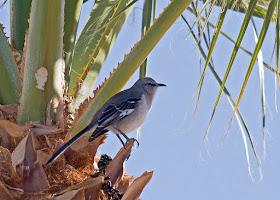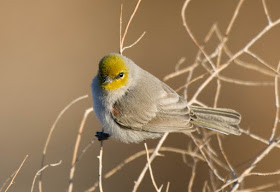 |
| Royal Terns. Mission Bay, California. January 21, 2017. Greg Gillson. |
Pages
▼
Tuesday, February 28, 2017
Monday, February 27, 2017
Sunday, February 26, 2017
Saturday, February 25, 2017
Burrowing Owl at Mission Bay
"The greatest concentration [of breeding Burrowing Owls] on Otay Mesa is at the mesa's extreme east end, at the southwest base of Otay Mountain, where the scrub is kept very open by frequent fires, started by children in Tijuana tossing burning objects over the international fence to taunt the Border Patrol." --San Diego County Bird Atlas, 2004, by Philip Unitt, page 287.
In that 2004 reference quoted above, Unitt predicted that the Burrowing Owl would be the next breeding species to become extinct in San Diego County. They were widespread, but sparse breeders, back then, and had become much rarer than in the past. The needed habitat is grasslands and open scrub, kept that way by frequent quick fires and protected from other uses during the breeding season. Ironically, eBird data suggests that the only breeding location for these owls that still remains today in the county seems to be Otay Mesa.
Burrowing Owls from inland in western North America migrate south. Several of these birds winter in San Diego County using ground squirrel burrows and road culverts. I've seen them at the Ramona Grasslands Preserve. But often they show up right on the edge of busy coastal residential areas.
One such bird showed up along the San Diego River mouth in late October 2016. It is on the edge of a road/bike path/hiking trail near SeaWorld theme park. It is easy to see and within 10 feet of the road, where it attracts a lot of attention from the hundreds of people passing by daily. It will probably remain through March before migrating back to wherever its summer home is located.
In that 2004 reference quoted above, Unitt predicted that the Burrowing Owl would be the next breeding species to become extinct in San Diego County. They were widespread, but sparse breeders, back then, and had become much rarer than in the past. The needed habitat is grasslands and open scrub, kept that way by frequent quick fires and protected from other uses during the breeding season. Ironically, eBird data suggests that the only breeding location for these owls that still remains today in the county seems to be Otay Mesa.
Burrowing Owls from inland in western North America migrate south. Several of these birds winter in San Diego County using ground squirrel burrows and road culverts. I've seen them at the Ramona Grasslands Preserve. But often they show up right on the edge of busy coastal residential areas.
One such bird showed up along the San Diego River mouth in late October 2016. It is on the edge of a road/bike path/hiking trail near SeaWorld theme park. It is easy to see and within 10 feet of the road, where it attracts a lot of attention from the hundreds of people passing by daily. It will probably remain through March before migrating back to wherever its summer home is located.
 |
| Burrowing Owl amid ice plant. San Diego River mouth, Mission Bay, California. January 1, 2017. Greg Gillson. |
 |
| Burrowing Owl. Colored pencil. Greg Gillson. |
Friday, February 24, 2017
Thursday, February 23, 2017
Wednesday, February 22, 2017
Tuesday, February 21, 2017
Monday, February 20, 2017
Sunday, February 19, 2017
Saturday, February 18, 2017
Friday, February 17, 2017
Thursday, February 16, 2017
Wednesday, February 15, 2017
Tuesday, February 14, 2017
Monday, February 13, 2017
Chaparral Trail at Dixon Lake in early February
I arrived just about 8:00 AM, February 8th, 2017, at the parking lot at the entrance of Dixon Lake. On weekdays there is no entry fee. I had an hour-and-a-half before I needed to head to work. Rather than visiting the lake proper, I decided to stay up in the picnic area and chaparral above the north shore of the lake.
The first birds were heard as I opened the car door, before I even got out. A dozen American Robins were there--some already apparently paired up. One of the robins had ugly swollen legs, as several did here last year--probably a scaly mite infection. Several Dark-eyed Juncos were feeding in the lawn, some House Finches were flying about, a Mourning Dove was cooing, and a couple of Yellow-rumped Warblers were working the tops of the California pepper trees that were just getting the first warming rays of sun as they lined the parking lot.
I walked through the first picnic area and down the hill slightly to the adjacent Jack's Creek picnic area. There were fewer birds this morning here, still in shade. A Nuttall's Woodpecker was working the dead top of a sycamore branch.
Leaving the picnic area and crossing the road to the north leads to the trailhead for the Chaparral Trail. The mixed chaparral is heavy here. I'm still learning the plants, but laurel sumac and big clumps of chamise were mixed in with several species of evergreen oak trees. This trail follows a creek bed--usually dry, but now was running after several days of recent rains the past two weeks.
A trailside sign identified the oaks and called attention to a "coast wild lilac" but didn't give its scientific name. The three parallel veins running down the leaf identify it as a Ceanothus, but exactly which of the 50-60 species this is I am not sure.
Three species of evergreen oaks occur together here. Most of the larger oaks are coast live oaks. A sign brought attention to the more blue-gray smooth-edged leaves of the Engelmann's Oak. Some scrub oak were also present. And in the oaks,... Oak Titmouses.
The nature trail goes uphill for almost one-half mile. Near the top I've noted wintering Fox Sparrows in the past but had a hard time seeing them in the riparian tangles of brush and scrub oaks. The loud smacking "tchuck!" or "check!" call told me I was looking for the Sooty Fox Sparrows, or maybe one of the Slate-colored Fox Sparrows, but not the Thick-billed Fox Sparrows, which have a metallic "zink!" call. About 20 subspecies of Fox Sparrows can be divided into 4 groups (including the Eastern Red Fox Sparrows). These 4 groups are long overdue to be split into 4 separate species.
Eventually, I spotted some very pale (pale for Sooties), but evenly-colored Fox Sparrows, with dense breast markings. I obtained two completely out-of-focus and useless photos, and one fuzzy photo that I present here. This probably represents unalaschcensis--the palest of the Sooty Fox Sparrows. It is also the form that breeds farthest north and west--in the Aleutians. Sooty Fox Sparrows have a leapfrog migration, with the northernmost breeders migrating the farthest south. The dark breeding form near Vancouver, Canada barely migrates at all.
At the top of the nature trail the chaparral opens up into primarily Chamise (Adenostoma fasciculatum) interspersed with a few yucca--Our Lord's Candles (Hesperoyucca whipplei). The photo below shows the trail north into Daily Ranch from the nature trail. There is a seasonal pond mid-left in the photo below. A creek exits this pond via a culvert and splashes down the ravine to the right in this photo.
There haven't been any butterflies out for a couple of months. But this white butterfly with the orange tips to its wings was easy for me to look up and identify--the Pacific or Sara Orangetip (Anthocaris sara). It was perhaps 1-1/2 inches wingtip to wingtip. It even kept its wings open for me for a great photograph!
At this point I was running out of time, so returned directly down the nature trail again. There were a few of the red-barked Mission Manzanitas, with a few blossoms.
I then heard a light loose trill and spotted a singing Rufous-crowned Sparrow. After a few moments it came over to investigate me. Of the two photos below, the lower one seems to hold what I view as a more typical pose--short neck, flat head, and long rounded tail. The upper photo is more alert, which gives it an appearance similar to a giant Chipping Sparrow--which it otherwise is not shaped like.
In past visits I had noted a "something"--a ball of vegetable matter like a Brillo-pad. I found one again, remembered to get a photo of it, and found the source.
I believe this is Marah macrocarpus, also known as wild cucumber, bigroot, and chilcothe. It is similar to Marah oreganus, the old-man-in-the-ground gourd I knew in Oregon. It is less common than the similar and widespread Marah fabaceus that has similar common names: California manroot, bigroot.
My eBird Checklist of this hike.
eBird Hotspot for Dixon Lake.
My previous birding site guide to Dixon Lake (written June 2016).
Mary Beth Stowe's birding site guide to Dixon Lake (written about 2008).
The first birds were heard as I opened the car door, before I even got out. A dozen American Robins were there--some already apparently paired up. One of the robins had ugly swollen legs, as several did here last year--probably a scaly mite infection. Several Dark-eyed Juncos were feeding in the lawn, some House Finches were flying about, a Mourning Dove was cooing, and a couple of Yellow-rumped Warblers were working the tops of the California pepper trees that were just getting the first warming rays of sun as they lined the parking lot.
I walked through the first picnic area and down the hill slightly to the adjacent Jack's Creek picnic area. There were fewer birds this morning here, still in shade. A Nuttall's Woodpecker was working the dead top of a sycamore branch.
 |
| Nuttall's Woodpecker. |
 |
| There was actually water running in the creek! |
 |
| Wild Lilac (Ceanothus spp.) starting to bloom. |
 |
| Engelmann's Oak. |
 |
| Scrub Oak. |
Eventually, I spotted some very pale (pale for Sooties), but evenly-colored Fox Sparrows, with dense breast markings. I obtained two completely out-of-focus and useless photos, and one fuzzy photo that I present here. This probably represents unalaschcensis--the palest of the Sooty Fox Sparrows. It is also the form that breeds farthest north and west--in the Aleutians. Sooty Fox Sparrows have a leapfrog migration, with the northernmost breeders migrating the farthest south. The dark breeding form near Vancouver, Canada barely migrates at all.
 |
| Sooty Fox Sparrow -- probably unalaschcensis subspecies |
 |
| A dead yucca stalk stands as a sentinel over the chaparral. |
 |
| Pacific Orangetip |
 |
| Mission Manzanita starting to bloom. |
 |
| Alert Rufous-crowned Sparrow. |
 |
| Rufous-crowned Sparrow, typical pose. |
 |
| What is it? Wild cucumber. |
 |
| Wild cucumber. |
 |
| Nature Journal |
My eBird Checklist of this hike.
eBird Hotspot for Dixon Lake.
My previous birding site guide to Dixon Lake (written June 2016).
Mary Beth Stowe's birding site guide to Dixon Lake (written about 2008).
Sunday, February 12, 2017
Saturday, February 11, 2017
Friday, February 10, 2017
Thursday, February 9, 2017
Another Storm Wigeon
A very few male American Wigeons have pure white head, rather than speckled gray-brown. The green eye patch is really striking against the white. My post on Storm Wigeon from 3 years ago is actually the most popular post in my entire blog--I assume as much from duck hunters as birders, because the hunters are usually aware of the term, but birders are less aware of this rare individual variation.
 |
| "Storm Wigeon." American Wigeon variant. Escondido, California. December 12, 2016. Greg Gillson. |
































